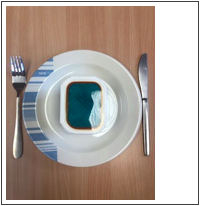Why did we need a special menu?
The PEACE project was implemented in three services where food is provided for service users in treatment for an eating disorder: an in-patient ward (Tyson West Two) and two day services, one working with patients seeking to progress towards full recovery (Daycare), the other supporting patients to improve quality of life and reduce hospital admission while continuing to live with an eating disorder (Step-Up).
Traditionally, these services aimed to reinstate regular eating safely, achieve recovery of healthy nutritional status, and work towards normal social eating behaviour. Food provided in these settings is planned to support this. However, people who have features of autistic spectrum disorder (ASD) in addition to an eating disorder may face severe challenges with using ordinary hospital food.
What were the problems the menu aimed to solve?
Some characteristics of ASD can result in multiple food aversions, affect appetite, and make eating physically uncomfortable. This may combine with social anxiety that is heightened at meal times to eating extremely difficult and distressing. This raises anxiety further, commonly causing loss of appetite for food, even nausea or vomiting, creating a vicious cycle of distress and food refusal. Features that can drive this include:
How does the PEACE Menu address these difficulties?
The PEACE team sought to find ways to make food provision more acceptable for individuals facing these difficulties. We agreed to offer some limited options as alternative to the main food provision. A menu of alternative meals was developed to:
Delivering the PEACE menu presented significant challenges to the hospital catering team, and the eating disorders clinical teams. Developing and delivering it needed strong collaboration from everyone involved. Service users’ views were collected in the regular catering group meetings, which were attended by the catering company dietitian and the head chef, who were key people in delivering the menu. The dietitians in the eating disorders teams introduced and explained the menu to service users in community group meetings, and individual sessions, and provided training and ongoing support for staff responsible for ordering and serving the food, and supporting service users at meal times. The menu and the way it is used continue to be developed in response to their suggestions.
How is the PEACE menu used?
When a service user has the initial assessment with a dietitian, the discussion includes exploration of issues that might be helped by the PEACE menu, including sensory aversions to foods, difficulties with making choices from a large number of options, anxieties about needing predictable and familiar food, and about keeping to rigid rules about eating. If the PEACE menu may help, the service user and dietitian will care plan how best to use it, and also consider how get ready to work on these challenges and recover more normal eating.
In the inpatients and Step Up services, the PEACE menu can also be used if any service user is not able to eat the meal they have chosen. If this happens, the service user can then make a care plan to use the PEACE menu if they should need it again. This can help service users feel safer to try more difficult foods. In these services, the menu is freely available, and displayed on a notice board.
In the way, any service user who needs it can use the options offered by the PEACE menu, but not more than once without careful discussion and planning.
Alternative Menu for Service Users, Tyson West Two and Step-Up
BREAKFAST Choose one juice and 2 other items, or one juice and a double portion cereal and milk | Vegan | Apple juice |
| Orange juice | ||
| Vegan (with soya milk) | Porridge with milk or soya milk | |
| Wheat biscuits with milk or soya milk | ||
| Bran flakes with milk or soya milk | ||
| Vegetarian | Prunes with Greek yogurt (can be served separately) | |
| Pears with Greek yogurt (can be served separately) | ||
| Apricots with Greek yogurt (can be served separately) | ||
Vegan (not with butter) | 2 slices white toast with butter, vegan spread or peanut butter | |
| 2 slices wholemeal toast with butter, spread or peanut butter | ||
LUNCH Choose juice or soup, 1 main course and 1 dessert | Vegan | Apple juice |
| Orange juice | ||
| Heinz vegetable soup | ||
| Vegetarian | Heinz tomato soup | |
| Vegetarian | Cheese sandwich on white bread with 1 packet plain crisps | |
| Vegan | 2 slices toast with 2 portions spread and 1 pot baked beans | |
| Tuna salad with mayonnaise and 2 slices bread and butter or spread | ||
| Vegetarian | Crackers with butter or spread, and cheese | |
| Vegan | Date and macadamia bar with fresh fruit of your choice | |
AFTERNOON SNACK Choose a drink and fruit | Vegan | 1 mug milk or soya milk |
| 1 mug all-milk or soya milk coffee | ||
| Fresh fruit of your choice | ||
DINNER Choose juice or soup, 1 main course and 1 dessert | Vegan | Apple juice |
| Orange juice | ||
| Heinz vegetable soup | ||
| Vegetarian | Heinz tomato soup | |
| Vegan | Lentil and sweet potato bake and vegetable | |
| Vegetarian | Plain omelette with mashed potatoes and vegetable | |
| Vegan | Peanut butter sandwich | |
| Vegetarian | Ice cream with a Twirl bar and a banana (can be served separately) | |
| Vegan | Doughnut with soya custard pot (can be served separately) | |
EVENING SNACK Choose a drink and toast or biscuits | Vegetarian | Malted milk, hot chocolate, or milk with sugar |
| Vegan | Hot soya milk with chocolate or sugar | |
Vegan (not with butter) | 1 slice white or wholemeal toast with butter or spread | |
| Vegetarian | 2 digestive biscuits |
• Early Stages - Getting Used to Regular Eating
You will probably begin your stay on the ward by choosing food from a menu which offers quite limited choices, and gradually increase the amount and variety of food you have, over a couple of weeks.
You will then be able to choose your food from the ward main menu. This menu offers a wide range of choices, and is different every day for 28 days, then begins again (the “four-week menu cycle”). The menu is developed from the main hospital menu, and offers dishes from a variety of cultures, with a wide range of cooking styles. It includes vegetarian and vegan options. It is carefully planned to ensure that whatever choices you make, the calories are about the same.
If the Main Menu is Not Always Right for You
We know that no menu can please everyone all the time, and there may be meals when you can’t find any option that you like, or feel able, to eat. You may feel a bit overwhelmed by the amount of choices, or find the food is too unfamiliar. To help, we also provide an alternative menu for lunch and dinner, with limited options of quite plain food. It is the same every day, though the choices at lunch and dinner are different. The calories match the main menu.
If you know you will find it difficult to choose from the main menu, arrange to see the dietitian as soon as possible, to make a care plan to meet your needs.
Times When You Can Use the Alternative Menu
Example pictures


Service User Feedback on The PEACE Menu
User Feedback was generally positive, even from people who did not use it. Some said just knowing it was available helped them to come into treatment, and to try working with the food. Others felt that knowing it was there might keep them stuck in using familiar foods of known content.
About two-thirds of in-patients used it at least once. Some relied on it heavily for a while, usually while they were settling into treatment. Some used it only once or twice.
To prevent service users becoming too reliant on the menu, care plans to use it are always made and regularly reviewed, except for a first-time use when a service user is not able to eat the planned meal.
You might find these interesting too!
Autism and ADHD can shape eating disorder behaviours in distinct ways. In this blog post by Lauren Makin, lived experiences of Neurodivergent adults with binge- and purge-type eating disorders highlight how sensory sensitivities, emotional regulation, routines, impulsivity, and social exclusion influence eating difficulties, and why more tailored, Neurodivergent-informed support is needed.
Welcome to Co-Produced by Peace+ Pathway. In this short intro episode, our hosts Adia, a clinician, and Lauren, a researcher, introduce themselves and the focus of the podcast.
A brief PEACE+ animation for people with ADHD and eating disorders. It explains how sensory, attention and interoceptive differences affect eating, and shares low-effort supports. Co-produced with clinicians and lived experience contributors.